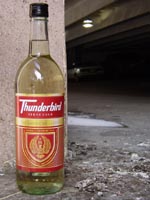 Click to be added!
Click to be added!
Posted on 04/03/2005 8:32:09 AM PDT by quantim
Ancient Egyptians believed in properly equipping a body for the afterlife, and not just through mummification. A new study reveals that King Tutankhamun eased his arduous journey with a stash of red wine.
Spanish scientists have developed the first technique that can determine the color of wine used in ancient jars. They analyzed residues from a jar found in the tomb of King Tut and found that it contained wine made with red grapes.
This is the only extensive chemical analysis that has been done on a jar from King Tut's tomb, and it is the first time scientists have provided evidence of the color of wine in an archaeological sample. The report appears in the March 15 edition of Analytical Chemistry, a peer-reviewed journal of the American Chemical Society, the world's largest scientific society.
The earliest scientific evidence of grapes is from 60-million-year-old fossil vines, while the first written record of winemaking comes from a much more recent source, the Bible, which says Noah planted a vineyard after exiting the ark.
Scientists have detected wine in a jar from as far back as 5400 B.C., found at the site of Hajji Firuz Tepe in the northern Zagros Mountains of present-day Iran. But the earliest knowledge about wine cultivation comes from ancient Egypt, where the winemaking process was represented on tomb walls dating to 2600 B.C.
"Wine in ancient Egypt was a drink of great importance, consumed by the upper classes and the kings," says Maria Rosa Guasch-Jané, a master in Egyptology at the University of Barcelona in Spain. She and Rosa M. Lamuela-Raventós, Ph.D., a professor of nutrition and food science, have analyzed samples of ancient Egyptian jars belonging to the Egyptian Museum in Cairo and the British Museum in London.
One sample came from the tomb of King Tutankhamun, discovered in 1922 by Howard Carter in Western Thebes, Egypt. The inscription on the jar reads: "Year 5. Wine of the House-of-Tutankhamun Ruler-of-the-Southern-On, l.p.h.[in] the Western River. By the chief vintner Khaa."
"Wine jars were placed in tombs as funerary meals," Guasch-Jané says. "The New Kingdom wine jars were labeled with product, year, source and even the name of the vine grower, but they did not mention the color of the wines they contained." Scientists and oenophiles have long debated the type of grape that ancient Egyptians used in their wines.
Using a new method for the identification of grape markers, Lamuela-Raventós and her coworkers determined that the wine in this jar was made with red grapes.
Tartaric acid, which is rarely found in nature from sources other than grapes, has been used before as a marker for the presence of wine in ancient residues, but it offers no information about the type of grape.
Malvidin-glucoside is the major component that gives the red color to young red wines, and no other juice used in the ancient Near East and Mediterranean region contains it. As wine ages, malvidin reacts with other compounds forming more complex structures. The researchers directed their efforts toward developing a tool for breaking down these structures to release syringic acid.
Analysis of ancient samples requires a very sensitive method to minimize the amount of sample that needs to be used. To detect syringic acid, the researchers used a technique called liquid chromatography and mass spectrometry in tandem mode, which is known for its high speed, sensitivity and selectivity. This method has never before been used to identify tartaric acid or syringic acid, nor has it been used on any archaeological sample, according to the scientists.
Ping.
I'd like to try a bottle of this if I could find it in a flea market somewhere.
alcoholic-ping
Paging Steve Martin.

(King Tut)
(King Tut)
Now when he was a young man,
He'd never thought he'd see,
(King Tut)
People stand in line,
To see the boy king.
(King Tut)
How'd you get so funky?
(Funky Tut)
They said you do the monkey.
(Born in Arizona, moved to Babylonia, King Tut)
(King Tut)
Please FREEPMAIL me if you want on, off, or alter the "Gods, Graves, Glyphs" PING list --
Archaeology/Anthropology/Ancient Cultures/Artifacts/Antiquities, etc.
The GGG Digest -- Gods, Graves, Glyphs (alpha order)
King Tut Exhibit Could Prove to Be Gold Mine
Reuters | Fri, Dec 03, 2004 | Jill Serjeant
Posted on 12/03/2004 11:09:30 PM PST by SunkenCiv
http://www.freerepublic.com/focus/f-chat/1294172/posts
BOOK FEATURE: The man who really found Tutankhamen (British Corporal Spy)
Middle East Times/World peace Times | March 31, 2005 | Desmond Zwar
Posted on 03/31/2005 1:45:59 PM PST by nickcarraway
http://www.freerepublic.com/focus/f-news/1374884/posts
King Tut Not Murdered, but Leg Fracture May Have Caused Infection, Tests Show
AP | Mar 8, 2005 | Paul Garwood
Posted on 03/08/2005 5:29:13 AM PST by Pharmboy
http://www.freerepublic.com/focus/f-news/1358339/posts
Smenkhkhare, the Hittite Pharaoh
BBC History | September 5, 2002 | Dr Marc Gabolde
Posted on 07/30/2004 9:42:36 AM PDT by SunkenCiv
http://www.freerepublic.com/focus/f-chat/1181802/posts
I wonder if I went to Egypt and played dead I could get me a good supply of wine?

The more I learn about the Little King, the more I like him.
7405 year old Thunder Bird?

No, but you might wind up with a lifetime supply of bandages...
You can get all the wine you want in Egypt. It will be very expensive and VERY BAD.
Disclaimer: Opinions posted on Free Republic are those of the individual posters and do not necessarily represent the opinion of Free Republic or its management. All materials posted herein are protected by copyright law and the exemption for fair use of copyrighted works.